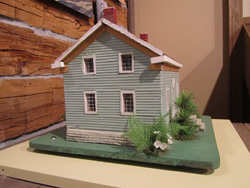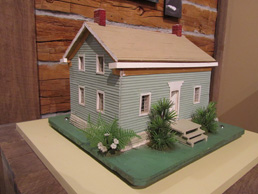January 17, 2014
Artifact: Mission House Model
Date: 1963
Significance: The house is a replica of the Indian Mission House in Shebahyonk, Michigan (now located in Sebewaing). It was made by George L. Buettner in cooperation with the director of CHI at the time, Dr. August Suelflow. Mission work with the Ojibwe (or Chippewa) began in the Sebewaing area in 1845 by Rev. Johann J. F. Auch, while an offshoot of this mission work was started in nearby Shebahyonk (8 miles away) by Rev. J. F. Maier three years later.

About the Mission House and the Shebahyonk Mission Work: The Indian Mission House in Shebahyonk was built in the spring of 1849. (The Shebahyonk mission was located on Saginaw Bay near the mouth of the Shebahyonk River.) It was a frame building, 20 by 30 feet in size, and had a large spacious room for church activities while serving as a residence for Missionary Maier. A log chapel had been built the year before and the mission house was placed adjacent to it. The mission house was dedicated on June 27, 1849, and Maier was installed as its pastor. An Ojibwe Christian congregation gradually formed there, numbering around forty people.
 Following Maier’s death in 1850, Rev. J. E. Roeder took over the work at Shebahyonk and lived in the mission house for two years. When Roeder accepted a call in 1853 to take over the Bethany Ojibwe mission at Saint Louis, Michigan, Rev. Auch continued the work at Shebahyonk. By this time the mission work at Sebewaing had dwindled due to more white settlers moving to the area, and Auch was only serving as the pastor of Immanuel Lutheran Church, founded by the settlers in 1851. Auch lived in the mission house at Shebahyonk while serving as its missionary but also continued as pastor to the congregation in Sebewaing.
Following Maier’s death in 1850, Rev. J. E. Roeder took over the work at Shebahyonk and lived in the mission house for two years. When Roeder accepted a call in 1853 to take over the Bethany Ojibwe mission at Saint Louis, Michigan, Rev. Auch continued the work at Shebahyonk. By this time the mission work at Sebewaing had dwindled due to more white settlers moving to the area, and Auch was only serving as the pastor of Immanuel Lutheran Church, founded by the settlers in 1851. Auch lived in the mission house at Shebahyonk while serving as its missionary but also continued as pastor to the congregation in Sebewaing.
Unfortunately the mission ended abruptly a year later. The mission board for the Missouri Synod decided to merge the Ojibwe at Shebahyonk with those at Bethany in 1854. At first, the group seemed agreeable to this move, but then a trader persuaded them not to move by spreading falsehoods about the missionary, the Bible and Christianity. Despite Auch’s many attempts to combat the accusations, the Ojibwe never relented, which was the death knell for the mission work at Shebahyonk.
One hundred years after the mission house was built, Charles F. Luckhard, who had bought the historical building in 1945, had it moved from its original location at Shebahyonk to a lot adjacent to Immanuel Lutheran Church in Sebewaing. He restored the interior to be much as it was when it was used for the mission and turned it into a museum.
(Most of the information above was gathered from C. F. Luckhard’s 1952 book, Faith in the Forest: A True Story of Pioneer Lutheran Missionaries, Laboring among the Chippewa Indians in Michigan, 1833-1868.)



